HNBS 311 Research Report: Analyzing Social Media Impact on Tourism
VerifiedAdded on 2020/12/09
|8
|1637
|359
Report
AI Summary
This research report investigates the impact of social media on the tourism industry, addressing its potential to expand customer bases and improve business performance. It identifies various social media tools like Facebook, Instagram, and Twitter and their role in enhancing marketing processes. The study uses a positivism research philosophy and an explanatory approach, employing both qualitative and quantitative methods to analyze data collected from primary and secondary sources. The research aims to understand the challenges faced by the tourism industry in leveraging social media and offers recommendations for improvement. Ethical considerations and research limitations, such as budget constraints and time consumption, are also acknowledged. The report concludes that social media can be a valuable asset for tourism organizations in attracting customers and promoting their services.
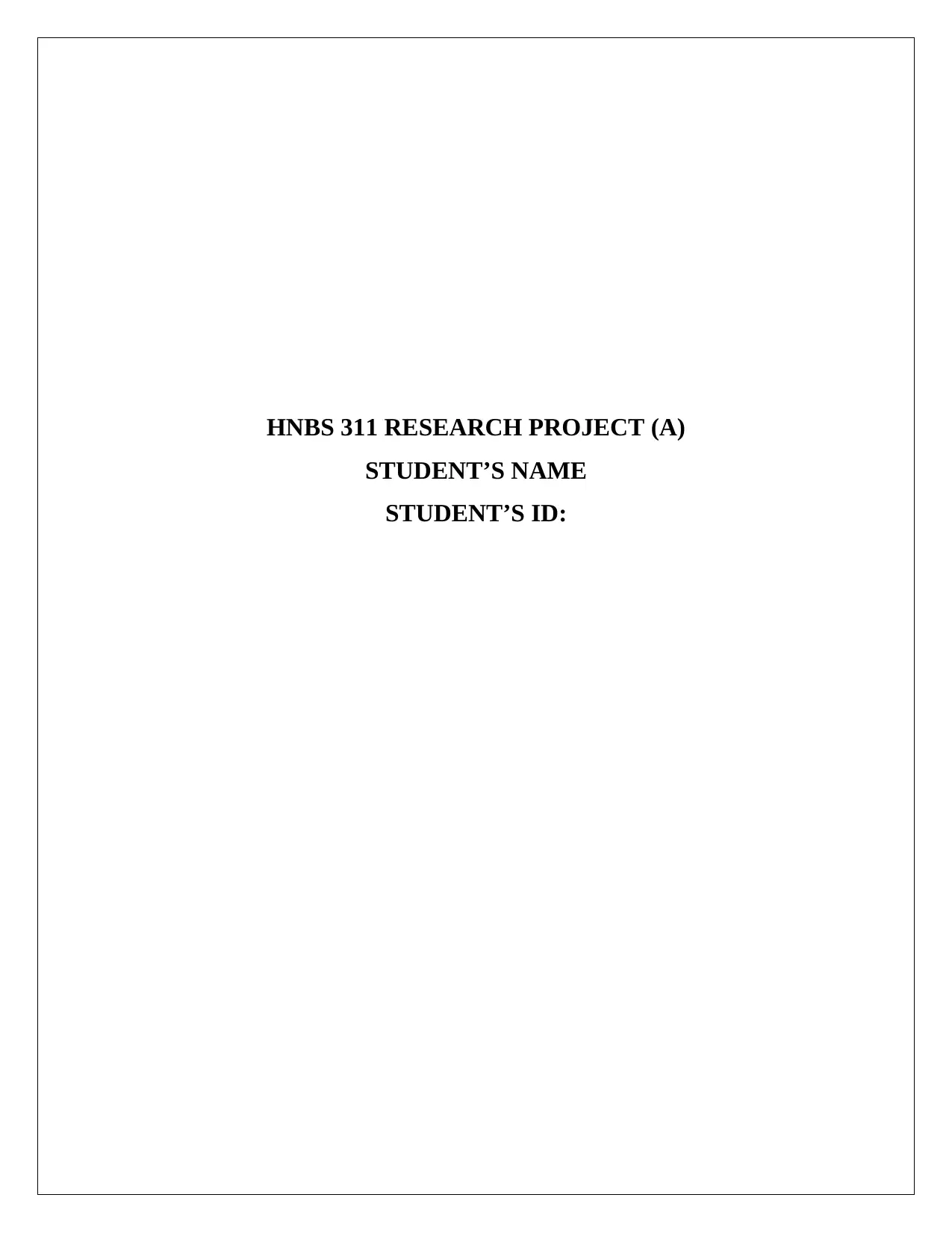
HNBS 311 RESEARCH PROJECT (A)
STUDENT’S NAME
STUDENT’S ID:
STUDENT’S NAME
STUDENT’S ID:
Paraphrase This Document
Need a fresh take? Get an instant paraphrase of this document with our AI Paraphraser
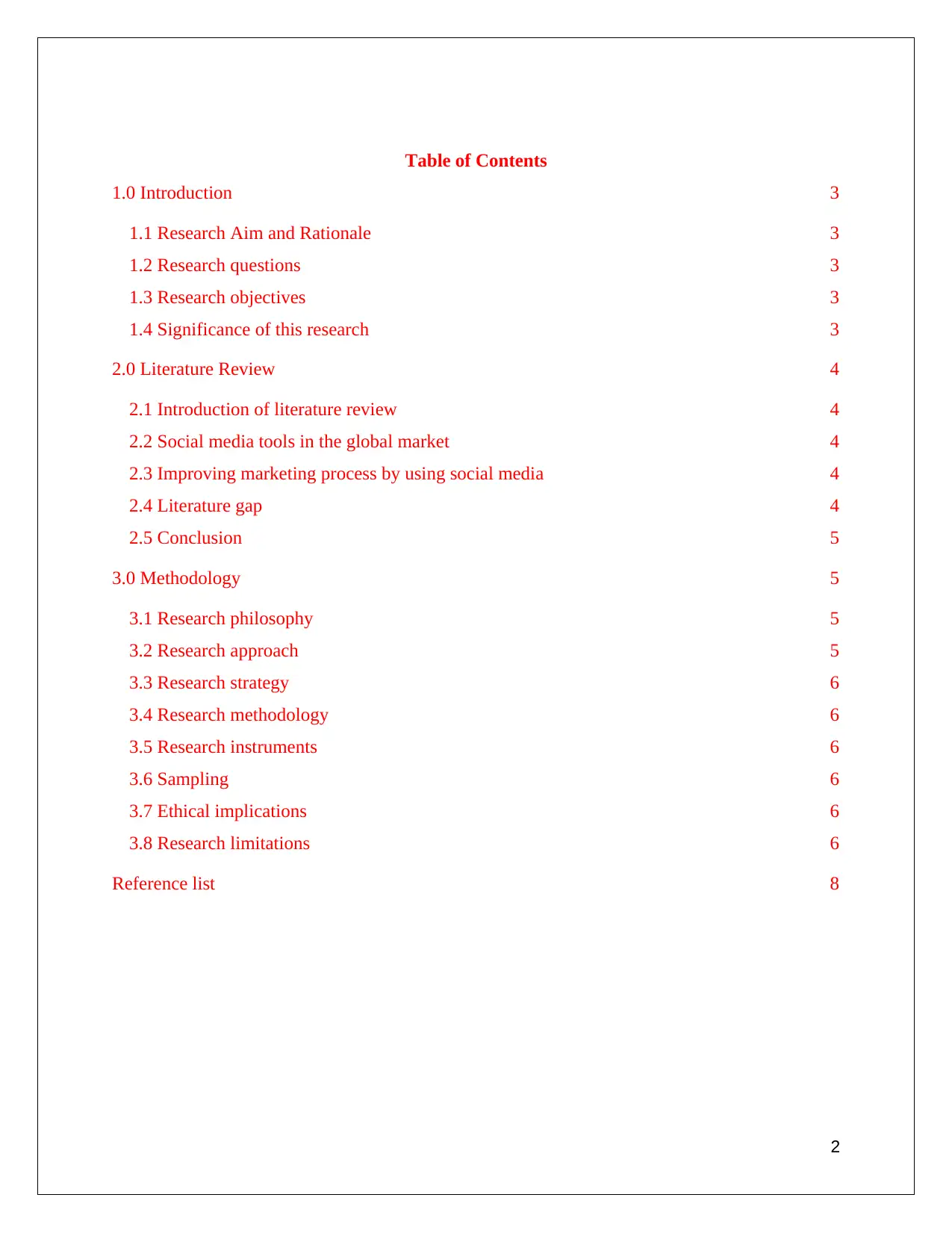
Table of Contents
1.0 Introduction 3
1.1 Research Aim and Rationale 3
1.2 Research questions 3
1.3 Research objectives 3
1.4 Significance of this research 3
2.0 Literature Review 4
2.1 Introduction of literature review 4
2.2 Social media tools in the global market 4
2.3 Improving marketing process by using social media 4
2.4 Literature gap 4
2.5 Conclusion 5
3.0 Methodology 5
3.1 Research philosophy 5
3.2 Research approach 5
3.3 Research strategy 6
3.4 Research methodology 6
3.5 Research instruments 6
3.6 Sampling 6
3.7 Ethical implications 6
3.8 Research limitations 6
Reference list 8
2
1.0 Introduction 3
1.1 Research Aim and Rationale 3
1.2 Research questions 3
1.3 Research objectives 3
1.4 Significance of this research 3
2.0 Literature Review 4
2.1 Introduction of literature review 4
2.2 Social media tools in the global market 4
2.3 Improving marketing process by using social media 4
2.4 Literature gap 4
2.5 Conclusion 5
3.0 Methodology 5
3.1 Research philosophy 5
3.2 Research approach 5
3.3 Research strategy 6
3.4 Research methodology 6
3.5 Research instruments 6
3.6 Sampling 6
3.7 Ethical implications 6
3.8 Research limitations 6
Reference list 8
2
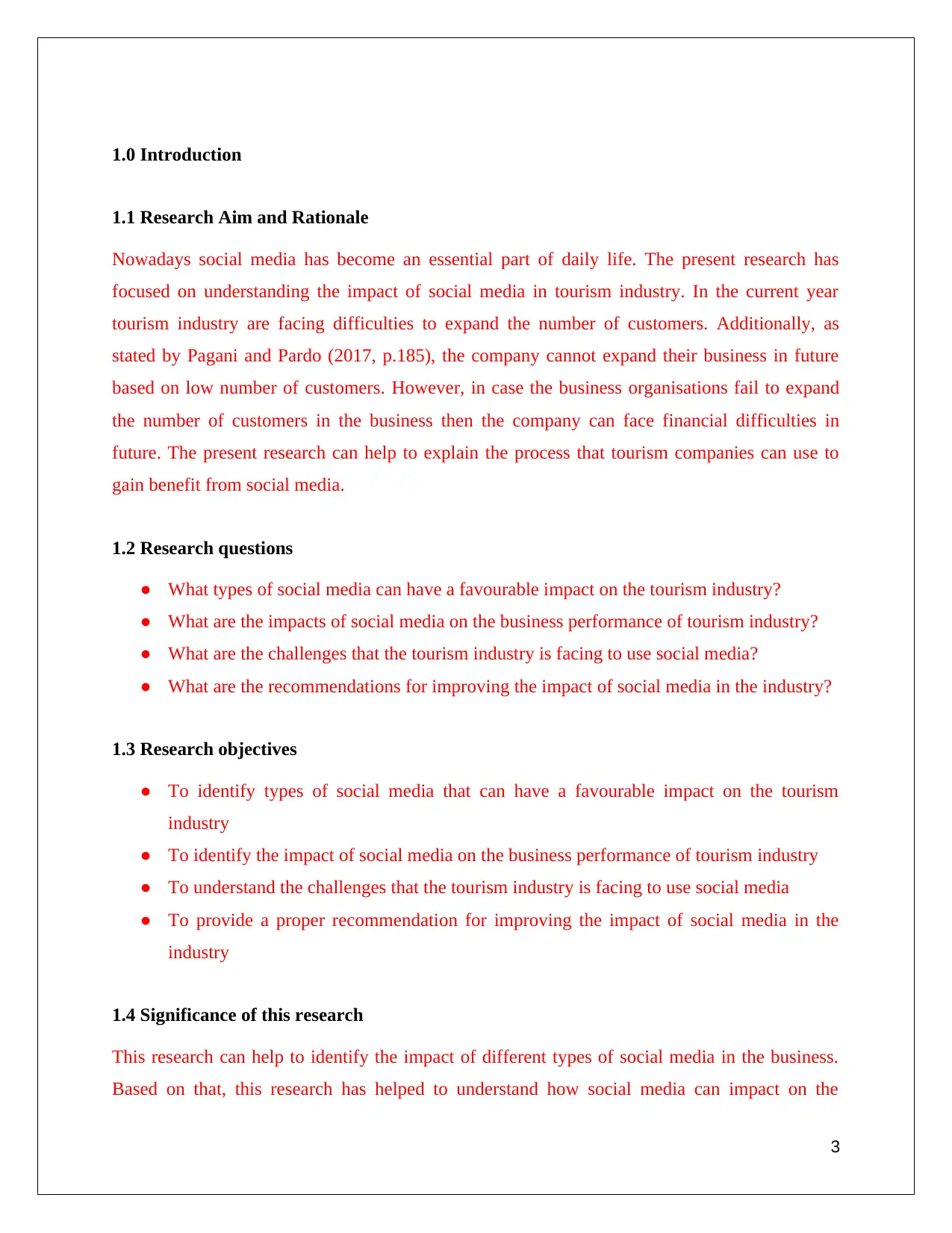
1.0 Introduction
1.1 Research Aim and Rationale
Nowadays social media has become an essential part of daily life. The present research has
focused on understanding the impact of social media in tourism industry. In the current year
tourism industry are facing difficulties to expand the number of customers. Additionally, as
stated by Pagani and Pardo (2017, p.185), the company cannot expand their business in future
based on low number of customers. However, in case the business organisations fail to expand
the number of customers in the business then the company can face financial difficulties in
future. The present research can help to explain the process that tourism companies can use to
gain benefit from social media.
1.2 Research questions
● What types of social media can have a favourable impact on the tourism industry?
● What are the impacts of social media on the business performance of tourism industry?
● What are the challenges that the tourism industry is facing to use social media?
● What are the recommendations for improving the impact of social media in the industry?
1.3 Research objectives
● To identify types of social media that can have a favourable impact on the tourism
industry
● To identify the impact of social media on the business performance of tourism industry
● To understand the challenges that the tourism industry is facing to use social media
● To provide a proper recommendation for improving the impact of social media in the
industry
1.4 Significance of this research
This research can help to identify the impact of different types of social media in the business.
Based on that, this research has helped to understand how social media can impact on the
3
1.1 Research Aim and Rationale
Nowadays social media has become an essential part of daily life. The present research has
focused on understanding the impact of social media in tourism industry. In the current year
tourism industry are facing difficulties to expand the number of customers. Additionally, as
stated by Pagani and Pardo (2017, p.185), the company cannot expand their business in future
based on low number of customers. However, in case the business organisations fail to expand
the number of customers in the business then the company can face financial difficulties in
future. The present research can help to explain the process that tourism companies can use to
gain benefit from social media.
1.2 Research questions
● What types of social media can have a favourable impact on the tourism industry?
● What are the impacts of social media on the business performance of tourism industry?
● What are the challenges that the tourism industry is facing to use social media?
● What are the recommendations for improving the impact of social media in the industry?
1.3 Research objectives
● To identify types of social media that can have a favourable impact on the tourism
industry
● To identify the impact of social media on the business performance of tourism industry
● To understand the challenges that the tourism industry is facing to use social media
● To provide a proper recommendation for improving the impact of social media in the
industry
1.4 Significance of this research
This research can help to identify the impact of different types of social media in the business.
Based on that, this research has helped to understand how social media can impact on the
3
⊘ This is a preview!⊘
Do you want full access?
Subscribe today to unlock all pages.

Trusted by 1+ million students worldwide
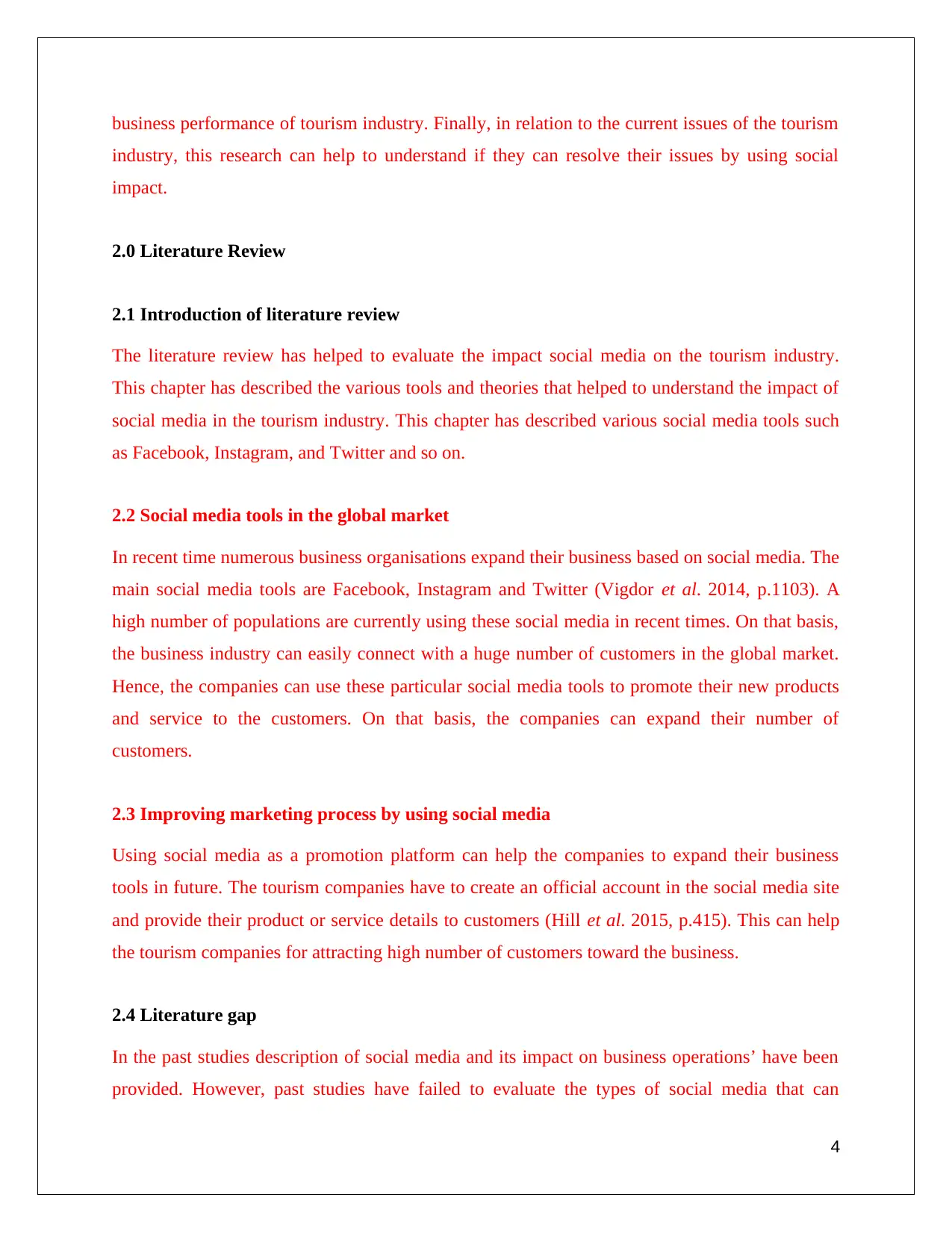
business performance of tourism industry. Finally, in relation to the current issues of the tourism
industry, this research can help to understand if they can resolve their issues by using social
impact.
2.0 Literature Review
2.1 Introduction of literature review
The literature review has helped to evaluate the impact social media on the tourism industry.
This chapter has described the various tools and theories that helped to understand the impact of
social media in the tourism industry. This chapter has described various social media tools such
as Facebook, Instagram, and Twitter and so on.
2.2 Social media tools in the global market
In recent time numerous business organisations expand their business based on social media. The
main social media tools are Facebook, Instagram and Twitter (Vigdor et al. 2014, p.1103). A
high number of populations are currently using these social media in recent times. On that basis,
the business industry can easily connect with a huge number of customers in the global market.
Hence, the companies can use these particular social media tools to promote their new products
and service to the customers. On that basis, the companies can expand their number of
customers.
2.3 Improving marketing process by using social media
Using social media as a promotion platform can help the companies to expand their business
tools in future. The tourism companies have to create an official account in the social media site
and provide their product or service details to customers (Hill et al. 2015, p.415). This can help
the tourism companies for attracting high number of customers toward the business.
2.4 Literature gap
In the past studies description of social media and its impact on business operations’ have been
provided. However, past studies have failed to evaluate the types of social media that can
4
industry, this research can help to understand if they can resolve their issues by using social
impact.
2.0 Literature Review
2.1 Introduction of literature review
The literature review has helped to evaluate the impact social media on the tourism industry.
This chapter has described the various tools and theories that helped to understand the impact of
social media in the tourism industry. This chapter has described various social media tools such
as Facebook, Instagram, and Twitter and so on.
2.2 Social media tools in the global market
In recent time numerous business organisations expand their business based on social media. The
main social media tools are Facebook, Instagram and Twitter (Vigdor et al. 2014, p.1103). A
high number of populations are currently using these social media in recent times. On that basis,
the business industry can easily connect with a huge number of customers in the global market.
Hence, the companies can use these particular social media tools to promote their new products
and service to the customers. On that basis, the companies can expand their number of
customers.
2.3 Improving marketing process by using social media
Using social media as a promotion platform can help the companies to expand their business
tools in future. The tourism companies have to create an official account in the social media site
and provide their product or service details to customers (Hill et al. 2015, p.415). This can help
the tourism companies for attracting high number of customers toward the business.
2.4 Literature gap
In the past studies description of social media and its impact on business operations’ have been
provided. However, past studies have failed to evaluate the types of social media that can
4
Paraphrase This Document
Need a fresh take? Get an instant paraphrase of this document with our AI Paraphraser
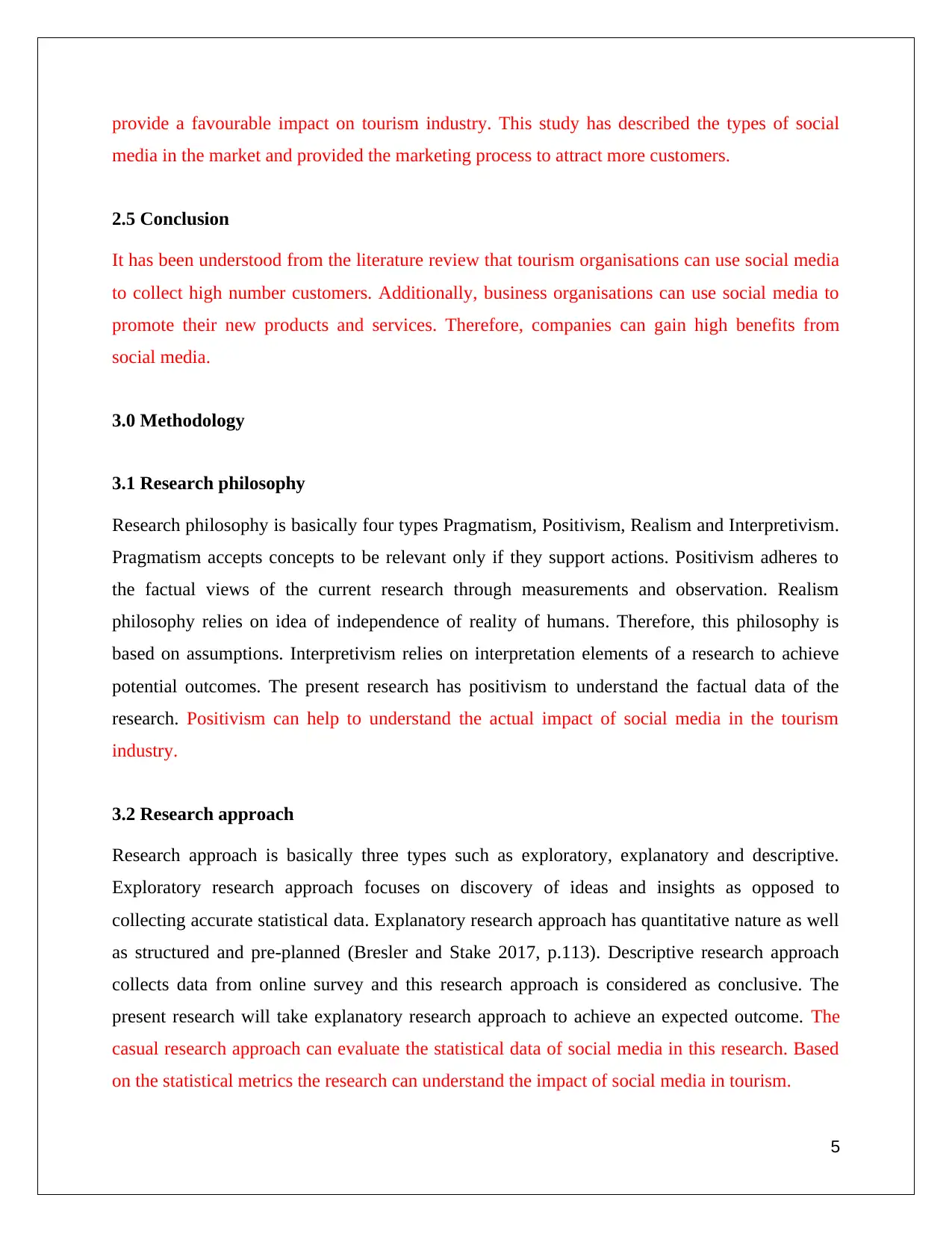
provide a favourable impact on tourism industry. This study has described the types of social
media in the market and provided the marketing process to attract more customers.
2.5 Conclusion
It has been understood from the literature review that tourism organisations can use social media
to collect high number customers. Additionally, business organisations can use social media to
promote their new products and services. Therefore, companies can gain high benefits from
social media.
3.0 Methodology
3.1 Research philosophy
Research philosophy is basically four types Pragmatism, Positivism, Realism and Interpretivism.
Pragmatism accepts concepts to be relevant only if they support actions. Positivism adheres to
the factual views of the current research through measurements and observation. Realism
philosophy relies on idea of independence of reality of humans. Therefore, this philosophy is
based on assumptions. Interpretivism relies on interpretation elements of a research to achieve
potential outcomes. The present research has positivism to understand the factual data of the
research. Positivism can help to understand the actual impact of social media in the tourism
industry.
3.2 Research approach
Research approach is basically three types such as exploratory, explanatory and descriptive.
Exploratory research approach focuses on discovery of ideas and insights as opposed to
collecting accurate statistical data. Explanatory research approach has quantitative nature as well
as structured and pre-planned (Bresler and Stake 2017, p.113). Descriptive research approach
collects data from online survey and this research approach is considered as conclusive. The
present research will take explanatory research approach to achieve an expected outcome. The
casual research approach can evaluate the statistical data of social media in this research. Based
on the statistical metrics the research can understand the impact of social media in tourism.
5
media in the market and provided the marketing process to attract more customers.
2.5 Conclusion
It has been understood from the literature review that tourism organisations can use social media
to collect high number customers. Additionally, business organisations can use social media to
promote their new products and services. Therefore, companies can gain high benefits from
social media.
3.0 Methodology
3.1 Research philosophy
Research philosophy is basically four types Pragmatism, Positivism, Realism and Interpretivism.
Pragmatism accepts concepts to be relevant only if they support actions. Positivism adheres to
the factual views of the current research through measurements and observation. Realism
philosophy relies on idea of independence of reality of humans. Therefore, this philosophy is
based on assumptions. Interpretivism relies on interpretation elements of a research to achieve
potential outcomes. The present research has positivism to understand the factual data of the
research. Positivism can help to understand the actual impact of social media in the tourism
industry.
3.2 Research approach
Research approach is basically three types such as exploratory, explanatory and descriptive.
Exploratory research approach focuses on discovery of ideas and insights as opposed to
collecting accurate statistical data. Explanatory research approach has quantitative nature as well
as structured and pre-planned (Bresler and Stake 2017, p.113). Descriptive research approach
collects data from online survey and this research approach is considered as conclusive. The
present research will take explanatory research approach to achieve an expected outcome. The
casual research approach can evaluate the statistical data of social media in this research. Based
on the statistical metrics the research can understand the impact of social media in tourism.
5
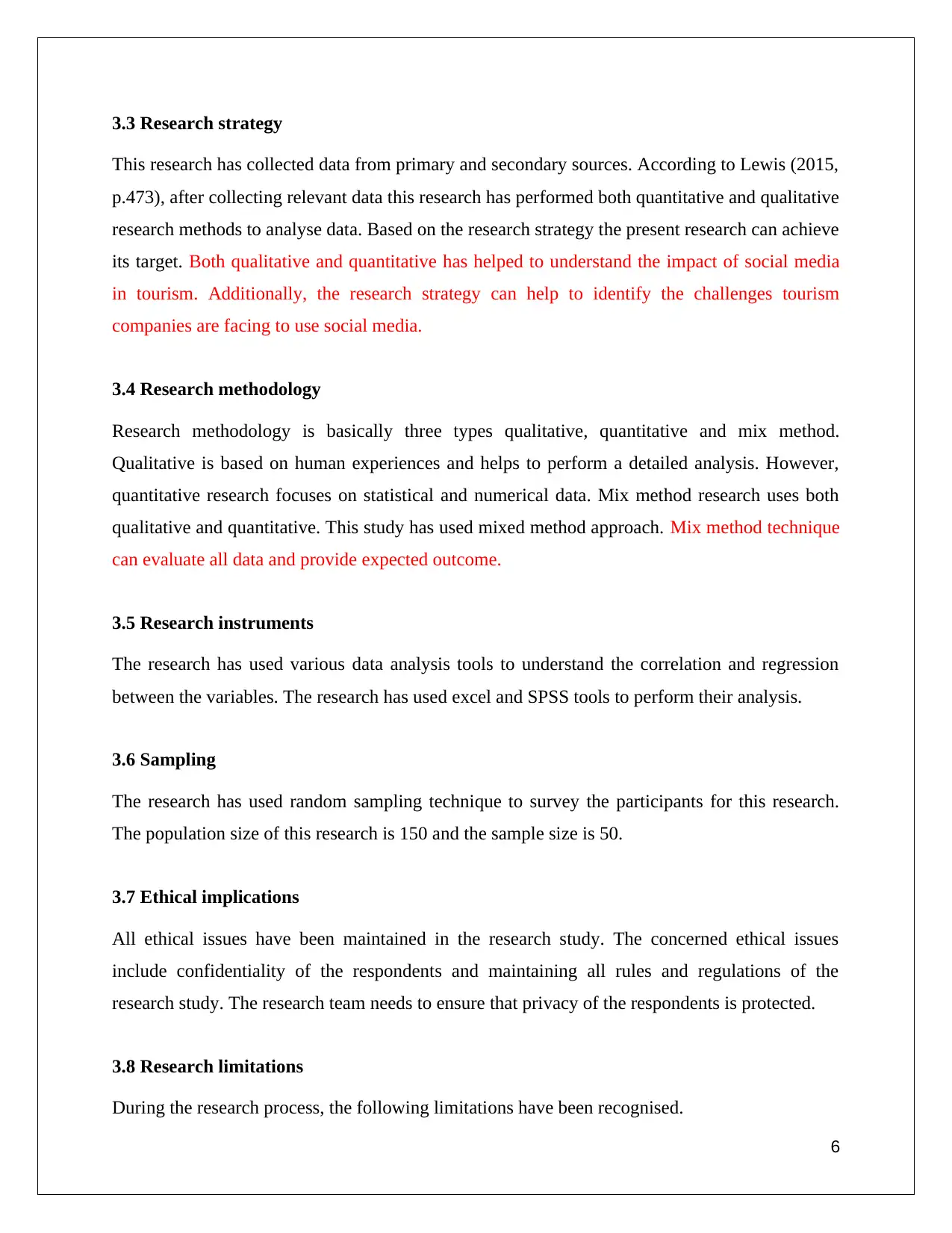
3.3 Research strategy
This research has collected data from primary and secondary sources. According to Lewis (2015,
p.473), after collecting relevant data this research has performed both quantitative and qualitative
research methods to analyse data. Based on the research strategy the present research can achieve
its target. Both qualitative and quantitative has helped to understand the impact of social media
in tourism. Additionally, the research strategy can help to identify the challenges tourism
companies are facing to use social media.
3.4 Research methodology
Research methodology is basically three types qualitative, quantitative and mix method.
Qualitative is based on human experiences and helps to perform a detailed analysis. However,
quantitative research focuses on statistical and numerical data. Mix method research uses both
qualitative and quantitative. This study has used mixed method approach. Mix method technique
can evaluate all data and provide expected outcome.
3.5 Research instruments
The research has used various data analysis tools to understand the correlation and regression
between the variables. The research has used excel and SPSS tools to perform their analysis.
3.6 Sampling
The research has used random sampling technique to survey the participants for this research.
The population size of this research is 150 and the sample size is 50.
3.7 Ethical implications
All ethical issues have been maintained in the research study. The concerned ethical issues
include confidentiality of the respondents and maintaining all rules and regulations of the
research study. The research team needs to ensure that privacy of the respondents is protected.
3.8 Research limitations
During the research process, the following limitations have been recognised.
6
This research has collected data from primary and secondary sources. According to Lewis (2015,
p.473), after collecting relevant data this research has performed both quantitative and qualitative
research methods to analyse data. Based on the research strategy the present research can achieve
its target. Both qualitative and quantitative has helped to understand the impact of social media
in tourism. Additionally, the research strategy can help to identify the challenges tourism
companies are facing to use social media.
3.4 Research methodology
Research methodology is basically three types qualitative, quantitative and mix method.
Qualitative is based on human experiences and helps to perform a detailed analysis. However,
quantitative research focuses on statistical and numerical data. Mix method research uses both
qualitative and quantitative. This study has used mixed method approach. Mix method technique
can evaluate all data and provide expected outcome.
3.5 Research instruments
The research has used various data analysis tools to understand the correlation and regression
between the variables. The research has used excel and SPSS tools to perform their analysis.
3.6 Sampling
The research has used random sampling technique to survey the participants for this research.
The population size of this research is 150 and the sample size is 50.
3.7 Ethical implications
All ethical issues have been maintained in the research study. The concerned ethical issues
include confidentiality of the respondents and maintaining all rules and regulations of the
research study. The research team needs to ensure that privacy of the respondents is protected.
3.8 Research limitations
During the research process, the following limitations have been recognised.
6
⊘ This is a preview!⊘
Do you want full access?
Subscribe today to unlock all pages.

Trusted by 1+ million students worldwide
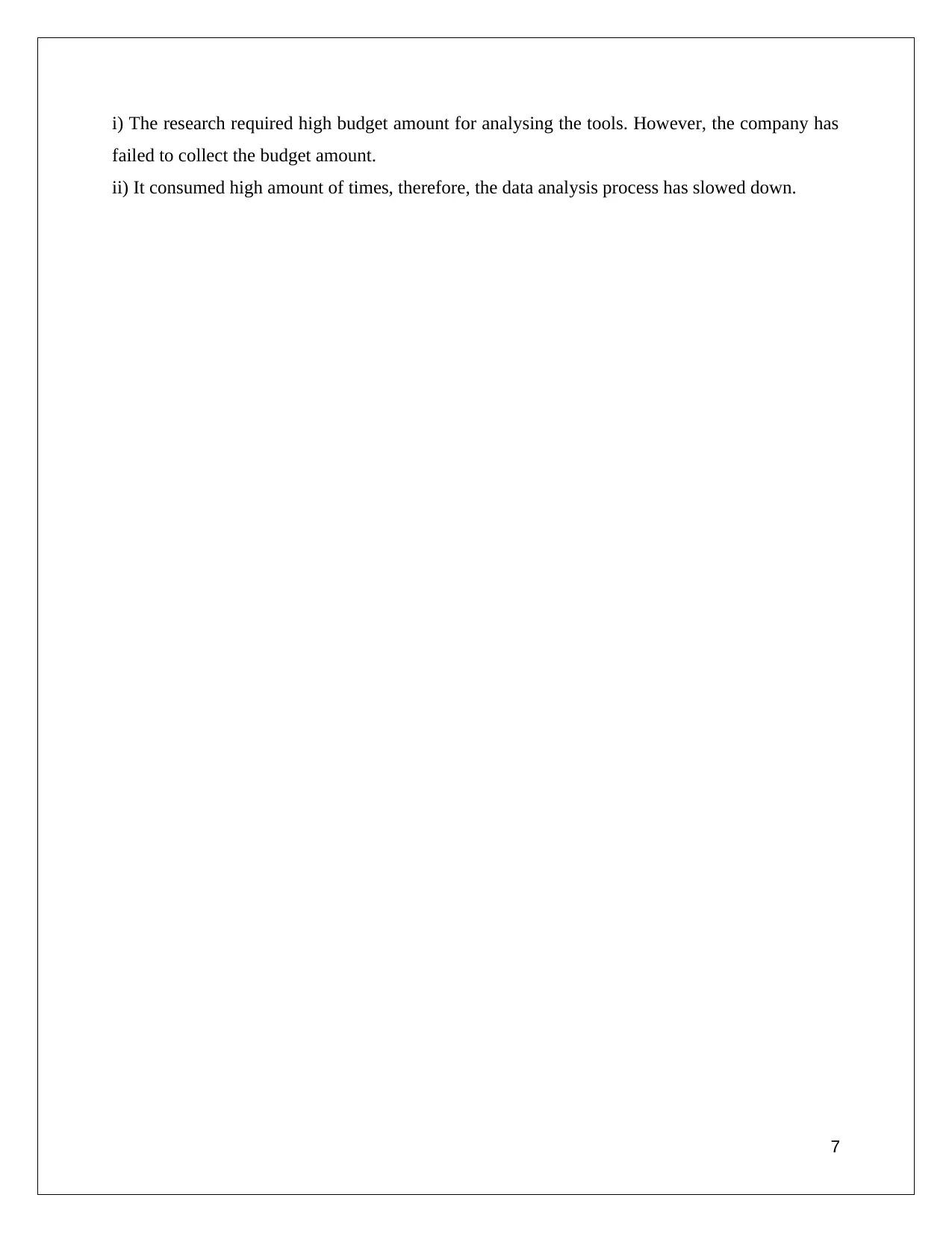
i) The research required high budget amount for analysing the tools. However, the company has
failed to collect the budget amount.
ii) It consumed high amount of times, therefore, the data analysis process has slowed down.
7
failed to collect the budget amount.
ii) It consumed high amount of times, therefore, the data analysis process has slowed down.
7
Paraphrase This Document
Need a fresh take? Get an instant paraphrase of this document with our AI Paraphraser
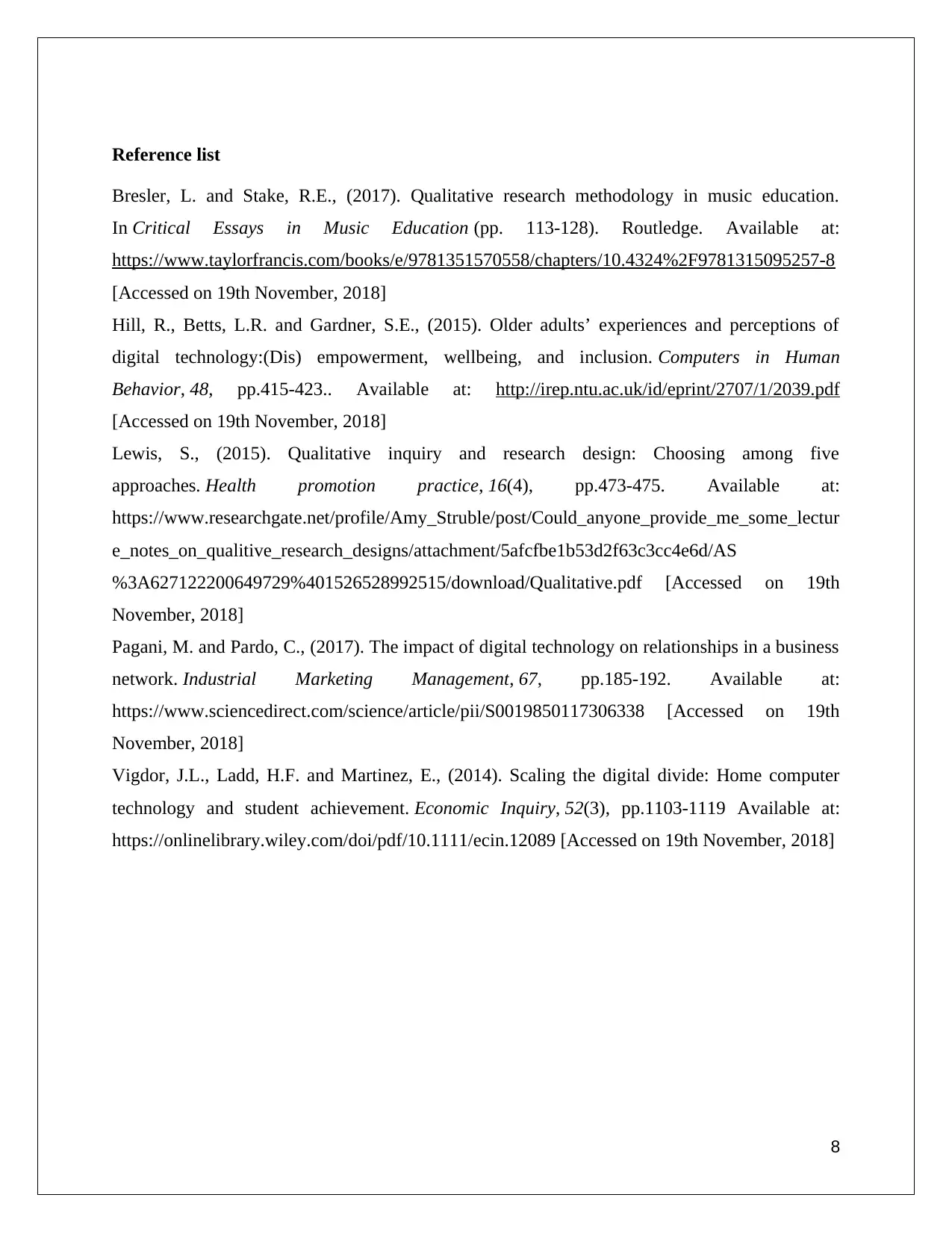
Reference list
Bresler, L. and Stake, R.E., (2017). Qualitative research methodology in music education.
In Critical Essays in Music Education (pp. 113-128). Routledge. Available at:
https://www.taylorfrancis.com/books/e/9781351570558/chapters/10.4324%2F9781315095257-8
[Accessed on 19th November, 2018]
Hill, R., Betts, L.R. and Gardner, S.E., (2015). Older adults’ experiences and perceptions of
digital technology:(Dis) empowerment, wellbeing, and inclusion. Computers in Human
Behavior, 48, pp.415-423.. Available at: http://irep.ntu.ac.uk/id/eprint/2707/1/2039.pdf
[Accessed on 19th November, 2018]
Lewis, S., (2015). Qualitative inquiry and research design: Choosing among five
approaches. Health promotion practice, 16(4), pp.473-475. Available at:
https://www.researchgate.net/profile/Amy_Struble/post/Could_anyone_provide_me_some_lectur
e_notes_on_qualitive_research_designs/attachment/5afcfbe1b53d2f63c3cc4e6d/AS
%3A627122200649729%401526528992515/download/Qualitative.pdf [Accessed on 19th
November, 2018]
Pagani, M. and Pardo, C., (2017). The impact of digital technology on relationships in a business
network. Industrial Marketing Management, 67, pp.185-192. Available at:
https://www.sciencedirect.com/science/article/pii/S0019850117306338 [Accessed on 19th
November, 2018]
Vigdor, J.L., Ladd, H.F. and Martinez, E., (2014). Scaling the digital divide: Home computer
technology and student achievement. Economic Inquiry, 52(3), pp.1103-1119 Available at:
https://onlinelibrary.wiley.com/doi/pdf/10.1111/ecin.12089 [Accessed on 19th November, 2018]
8
Bresler, L. and Stake, R.E., (2017). Qualitative research methodology in music education.
In Critical Essays in Music Education (pp. 113-128). Routledge. Available at:
https://www.taylorfrancis.com/books/e/9781351570558/chapters/10.4324%2F9781315095257-8
[Accessed on 19th November, 2018]
Hill, R., Betts, L.R. and Gardner, S.E., (2015). Older adults’ experiences and perceptions of
digital technology:(Dis) empowerment, wellbeing, and inclusion. Computers in Human
Behavior, 48, pp.415-423.. Available at: http://irep.ntu.ac.uk/id/eprint/2707/1/2039.pdf
[Accessed on 19th November, 2018]
Lewis, S., (2015). Qualitative inquiry and research design: Choosing among five
approaches. Health promotion practice, 16(4), pp.473-475. Available at:
https://www.researchgate.net/profile/Amy_Struble/post/Could_anyone_provide_me_some_lectur
e_notes_on_qualitive_research_designs/attachment/5afcfbe1b53d2f63c3cc4e6d/AS
%3A627122200649729%401526528992515/download/Qualitative.pdf [Accessed on 19th
November, 2018]
Pagani, M. and Pardo, C., (2017). The impact of digital technology on relationships in a business
network. Industrial Marketing Management, 67, pp.185-192. Available at:
https://www.sciencedirect.com/science/article/pii/S0019850117306338 [Accessed on 19th
November, 2018]
Vigdor, J.L., Ladd, H.F. and Martinez, E., (2014). Scaling the digital divide: Home computer
technology and student achievement. Economic Inquiry, 52(3), pp.1103-1119 Available at:
https://onlinelibrary.wiley.com/doi/pdf/10.1111/ecin.12089 [Accessed on 19th November, 2018]
8
1 out of 8
Related Documents
Your All-in-One AI-Powered Toolkit for Academic Success.
+13062052269
info@desklib.com
Available 24*7 on WhatsApp / Email
![[object Object]](/_next/static/media/star-bottom.7253800d.svg)
Unlock your academic potential
Copyright © 2020–2025 A2Z Services. All Rights Reserved. Developed and managed by ZUCOL.





